Dual Core Stress Test: AMD vs. Intel
Stability: Intel With Intel, AMD With NVIDIA
Stability is an important topic for professional-level situations, and there were some surprises in this respect: with the Intel system, three motherboards with the nForce SLI chipset turned out to be problematic. There were several crashes, and in one case the voltage regulator even burned out.
The only thing that could help stabilize the system was to combine the Intel CPU with the Intel chipset, which then of course rules out a SLI graphics configuration. However, in exchange, the user does gain the benefit of stability - our Intel system ran for 14 days without a problem. The AMD system ran smoothly from the start, which leads us to conclude that the nForce SLI basis is stable with the AMD platform. The only downside was that after long periods of operation, the AMD machine wouldn't shut down via software.
In the end, we can conclude that the Intel Pentium 840 EE should be used with a motherboard that has the Intel 955X chipset. We do not recommend its use with a board with NVIDIA's nForce4 SLI chipset.
With the AMD platform you've only got one option, which fortunately is stable: to combine the AMD platform with a motherboard based on NVIDIA's nForce4 SLI chipset. The results of our stress test show that the nForce4 SLI chipset for the AMD platform has matured.
Power Consumption And Costs
| Header Cell - Column 0 | Intel | AMD |
|---|---|---|
| Row 0 - Cell 0 | No Load | |
| Power consumption | 182 W | 161 W |
| Consumption per year | 1594 kWh | 1410 kWh |
| Cost per year (at 8.5 cents per kWh) | $135.49 | $119.85 |
| Row 4 - Cell 0 | Full Load (including graphics) | |
| Power consumption | 342 W | 269 W |
| Consumption per year | 2995 kWh | 2356 kWh |
| Cost per year (at 8.5 cents per kWh) | $254.58 | $200.26 |
| Row 8 - Cell 0 | Full Load (without graphics) | |
| Power consumption | 295 W | 228 W |
| Consumption per year | 2584 kWh | 1997 kWh |
| Cost per year (at 8.5 cents per kWh) | $219.64 | $169.75 |
The table above gives you a clear picture of how each system sizes up with regard to power consumption. This should be especially interesting for the business sector, where many systems are used, meaning that costs add up.
With no load on the systems, you can already see the difference between the Intel and the AMD platforms - the Intel system uses 13% more power than AMD. This increases to 30% when both systems are running under a full load. The table also shows you what this all amounts to per year for each system: there's a difference of $54 when both systems are running round the clock under a full load. Just think about how smaller companies might easily install 100 systems, and what a difference the extra $5,400 would make! Note that we're only talking about the electricity costs here.
Get Tom's Hardware's best news and in-depth reviews, straight to your inbox.
Current page: Stability: Intel With Intel, AMD With NVIDIA
Prev Page Stress Test: Athlon 64 X2 4800+ Vs. Pentium 840 EE Next Page Video For Download: The Stress Test, Live From The THG Lab